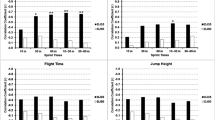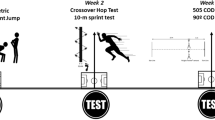Abstract
Purpose
This study aimed to investigate the relationship between the explosive strength ratio, which is the quotient between maximum height achieved after counter-movement jump with arm and maximum height achieved after standing start jump, and the 30-m sprint performance.
Method
Eighty-four children performed a series of 30-m sprints, Counter-movement jump with arm (arm-CMJ) and Starting Long Jump (SLJ) (with both legs) in randomized block order during the same testing session. Pearson’s product moment correlation coefficients (r) were used to determine the relationship between the explosive strength ratio and sprint performance. The coefficients of determination (R 2) were used to examine the amount of explained variance between tests. Stepwise multiple regression analysis was used to estimate the best predictor model of sprint performance.
Results
The correlation coefficient between explosive strength Ratio: arm-CMJ/SLJ, 10, and 30-m sprint time was moderate (r = 0.40 and 0.48 respectively). However, correlation with flying time 10 < 30-m sprint time (r = 0.52) was large. The Ratio: arm-CMJ/SLJ was the best single predictor factor (p < 0.001) of the flying time 10 < 30-m sprint time, and explained 27 % of the variance.
Conclusion
For improving sprint performance as well as maximal speed and flying time, coaches could ensure the explosive strength ratio as an index to calibrate sprint development program and also for enhancing sport speed in children. They will be able to use this finding to better test and monitor children’s athletes requiring different skills and to evaluate the effects of speed training in children.

Similar content being viewed by others
References
Attene G, Pizzolato F, Calcagno G, Ibba G, Pinna M, Salernitano G, Padulo J (2014) Sprint vs. intermittent training in young female basketball players. J Sports Med Phys Fit 54:154–161
Baker B, Nance S (1999) The relation between running speed and measures of strength and power in professional rugby league players. J Strength Cond Res 13:230–235
Barr MJ, Nolte VW (2011) Which measure of drop jump performance best predicts sprinting speed? J Strength Cond Res 25:1976–1982
Brechue WF, Mayhew JL, Piper FC (2010) Characteristics of sprint performance in college football players. J Strength Cond Res 24:1169–1178
Buchheit M, Mendez-Villanueva A, Delhomel G, Brughelli M, Ahmaidi S (2010) Improving repeated sprint ability in young elite soccer players: repeated shuttle sprints vs. explosive strength training. J Strength Cond Res 24:2715–2722
Chaleh M, Fatemi R, Shahsavar A (2012) Relationship between speed, agility and anaerobic power of 14–16 years elite soccer players. Int J Appl Basic Sci 3:127–432
Christou M, Smilios I, Sotiropoulos K, Volaklis K, Pilianidis T, Tokmakidis SP (2006) Effects of resistance training on the physical capacities of adolescent soccer players. J Strength Cond Res 20:783–791
Comfort P, Stewart A, Bloom L, Clarkson B (2014) Relationships between strength, sprint, and jump performance in well-trained youth soccer players. J Strength Cond Res 28:173–177
Copaver KB, Hertogh C, Hue O (2012) Sprint performance changes and determinants in afro-Caribbean adolescents between 13 and 15 years old. J Hum Kinet 34:89–98
Cronin JB, Hansen KT (2005) Strength and power predictors of sports speed. J Strength Cond Res 19:349–357
Duthie G, Pyne D, Hooper S (2003) Applied physiology and game analysis of rugby union. Sports Med 33:973–991
Haddad M, Dridi A, Chtara M, Chaouachi A, Wong dP, Behm D, Chamari K (2014) Static stretching can impair explosive performance for at least 24 hours. J Strength Cond Res 28:140–146
Harries SK, Lubans DR, Callister R (2012) Resistance training to improve power and sports performance in adolescent athletes: a systematic review and meta-analysis. J Sci Med Sport 15:532–540
Harrison AJ, Bourke G (2009) The effect of resisted sprint training on speed and strength performance in male rugby players. J Strength Cond Res 23:275–283
Hopkins WG, Marshall SW, Batterham AM, Hanin J (2009) Progressive statistics for studies in sports medicine and exercise science. Med Sci Sports Exerc 41:3–13
Hudgins B, Scharfenberg J, Triplett NT, McBride JM (2013) Relationship between jumping ability and running performance in events of varying distance. J Strength Cond Res 27:563–567
Hunter JP, Marshall RN, McNair PJ (2005) Relationships between ground reaction force impulse and kinematics of sprint-running acceleration. J Appl Biomech 21:31–43
Ibba G, Pizzolato F, Di Michele R, Scorcu M, Attene G, Paradisis G, Anon P, Padulo J (2014) Uphill sprint vs. intermittent running in young soccer players: acute physiological responses. Sport Sci Health 10(2):61–66
Kuitunen S, Komi PV, Kyrolainen H (2002) Knee and ankle joint stiffness in sprint running. Med Sci Sports Exerc 34:166–173
Kukolj M, Ropret R, Ugarkovic D, Jaric S (1999) Anthropometric, strength, and power predictors of sprinting performance. J Sports Med Phys Fit 39:120–122
Kyrolainen H, Belli A, Komi PV (2001) Biomechanical factors affecting running economy. Med Sci Sports Exerc 33:1330–1337
Laffaye G, Collin JM, Levernier G, Padulo J (2014) Upper-limb power test in rock-climbing. Int J Sports Med 35(8):670–675. doi:10.1055/s-0033-1358473
Lloyd RS, Oliver JL, Hughes MG, Williams CA (2009) Reliability and validity of field-based measures of leg stiffness and reactive strength index in youths. J Sports Sci 27:1565–1573
Mero A, Komi PV, Gregor RJ (1992) Biomechanics of sprint running. A review. Sports Med 13:376–392
Meylan C, Malatesta D (2009) Effects of in-season plyometric training within soccer practice on explosive actions of young players. J Strength Cond Res 23:2605–2613
Meylan CM, Cronin JB, Oliver JL, Hughes MG, McMaster DT (2012) The reliability of jump kinematics and kinetics in children of different maturity status. J Strength Cond Res 26:1015–1026
Mikkola J, Vesterinen V, Taipale R, Capostagno B, Hakkinen K, Nummela A (2011) Effect of resistance training regimens on treadmill running and neuromuscular performance in recreational endurance runners. J Sports Sci 29:1359–1371
Morin JB, Bourdin M, Edouard P, Peyrot N, Samozino P, Lacour JR (2012) Mechanical determinants of 100-m sprint running performance. Eur J Appl Physiol 112:3921–3930
Munro CF, Miller DI, Fuglevand AJ (1987) Ground reaction forces in running: a reexamination. J Biomech 20:147–155
Nummela A, Keranen T, Mikkelsson LO (2007) Factors related to top running speed and economy. Int J Sports Med 28:655–661
Padulo J, Di Giminiani R, Ibba G, Zarrouk N, Moalla W, Attene G, Migliaccio M, Pizzolato F, Bishop D, Chamari K (2014) The acute effect of whole body vibration on repeated shuttle-running in young soccer players. Int J Sports Med 35:49–54
Padulo J, Mignogna P, Mignardi S, Tonni F, D’Ottavio S (2012) Effect of different pushing speeds on bench press. Int J Sports Med 33:376–380
Padulo J, Tiloca A, Powell D, Granatelli G, Bianco A, Paoli A (2013) EMG amplitude of the biceps femoris during jumping compared to landing movements. Springerplus 2:520
Pyne DB, Gardner AS, Sheehan K, Hopkins WG (2005) Fitness testing and career progression in AFL football. J Sci Med Sport 8:321–332
Rumpf MC, Cronin JB, Pinder SD, Oliver J, Hughes M (2012) Effect of different training methods on running sprint times in male youth. Pediatr Exerc Sci 24:170–186
Smith DJ (2003) A framework for understanding the training process leading to elite performance. Sports Med 33:1103–1126
Vando S, Filingeri D, Maurino L, Chaabene H, Bianco A, Salernitano G, Foti C, Padulo J (2013) Postural adaptations in preadolescent karate athletes due to a one week karate training camp. J Hum Kinet 38:45–52
Vando S, Unim B, Cassarino SA, Padulo J, Masala D (2013) Effectiveness of perceptual training-proprioceptive feedback in a virtual visual diverse group of healthy subjects: a pilot study. Epidemiol Biostat Public Health 10:e8844-1–e8844-10
Vescovi JD, McGuigan MR (2008) Relationships between sprinting, agility, and jump ability in female athletes. J Sports Sci 26:97–107
Young W, Cormack S, Crichton M (2011) Which jump variables should be used to assess explosive leg muscle function? Int J Sports Physiol Perform 6:51–57
Acknowledgments
This study was not supported by any sources of funding.
Conflict of interest
There are no conflicts of interest in this paper.
Author information
Authors and Affiliations
Corresponding author
Rights and permissions
About this article
Cite this article
Hammami, R., Makhlouf, I., Chtara, M. et al. The contribution of vertical explosive strength to sprint performance in children. Sport Sci Health 11, 37–42 (2015). https://doi.org/10.1007/s11332-014-0200-2
Received:
Accepted:
Published:
Issue Date:
DOI: https://doi.org/10.1007/s11332-014-0200-2




